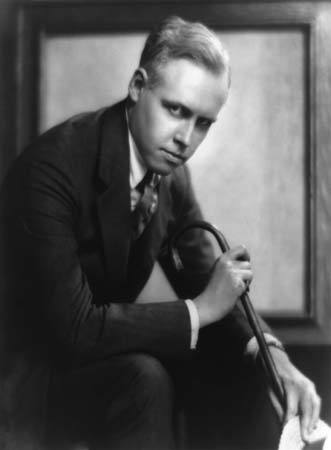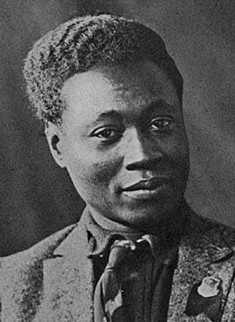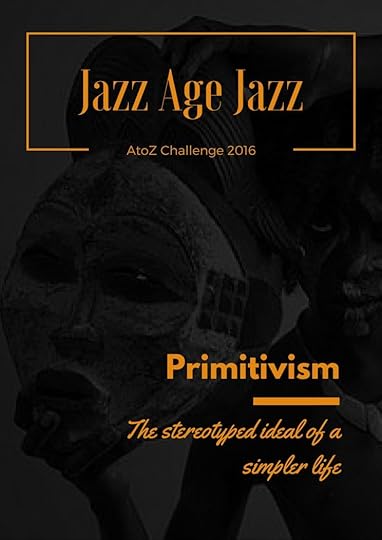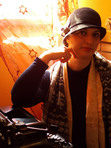Primitivism (AtoZ Challenge 2016 – Jazz Age Jazz)
JAZZ AGE JAZZ - Primitivism #AtoZChallenge The illusion of a simpler life
Click To Tweet
 In the 1920s, Sigmund Freud’s psychoanalysis became very popular even outside of his professional field. This was true especially in the US and may be one of the factors that cause a revival of Primitivism.
In the 1920s, Sigmund Freud’s psychoanalysis became very popular even outside of his professional field. This was true especially in the US and may be one of the factors that cause a revival of Primitivism.
Primitivism argued that emotional repression had become endemic in the Western world and invested ‘primitive’ cultures with ‘uncivilized values’ that could cure this illness and rejuvenate the tired Western society by freeing its more natural desires – particularly sexuality.
Primitivism pre-dated the 1920s. American writers had created many primitive worlds and characters. In these stories, Native Americans and African Americans often played the idealised role of the noble savage or the fearsome barbarian. It was a depiction that had nothing realistic to it. In the light of Primitivism, different cultures were idealized (for good and bad) so to match a particular idea and stereotype, not to actually describe them as they were. They became a vehicle of an ideology, not the portrayal of real people.
 Carl Van Vechten
Carl Van VechtenFor this reason, Primitivism never sparkled any true interest in the culture being depicted.
It was mostly a fantasy that often referred back to other ideas important to the artist.
Writers like F. Scott Fitzgerald and Carl Van Vechten, for example, were noted for their forays into Primitivism. Although keenly interested in the jazz culture, they mostly displayed a more general interest in modernism and supernaturalism than true interest in jazz culture. To them, jazz was a symbol, a metaphor of the life as they experienced it. It never became the experience as it was for many Harlem Renaissance innovators. Authors like Langston Hughes and Claude McKay not only depicted jazz as a significant experience in itself, but they went as far as using jazz as a language for their stories.
Entrepreneurs played the idea of Primitivism to such an extent that the plantation life – or rather the stereotyped ideal of plantation life – haunted black entertainment for a long time. Vaudeville, minstrelsy and other stage performances had prepared white audience to expect a certain kind of stereotype. While this certainly damaged African American culture, it may even have trapped both blacks and whites into roles that were not ‘authentic’ but staged.
Jazz became part of this game.
 Claude McKay
Claude McKayThe clubs where jazz was played bore names (The Cotton Club, the Plantation Club, the Alabama Club) that used words geographically separated from North and East and culturally unfamiliar to many patrons. The interior décor also played the idea of a different place, unknown and exotic. Everything was constructed so to suggest a displacement, almost a relocation in a different world, a recognizable fantasy. But structure of clubs didn’t encourage participation, it was rather voyeurism. Patrons assumed they were part of black music and performance, that they had entered that exotic world to enjoy whatever unusual experience it had to offer. They were in fact just viewers watching in from a safe, separate position. Patrons could witness and sometimes act in behaviour that were typically ‘off limits’ in everyday life and this created the illusion that the ‘civilised’ barrier had gone down and one would connect with the other. But that’s exactly what it was: a well orchestrated illusion.
To the larger public, African arts were an ideal of a simpler, more intense, more primeval experience of life. African American performance was a natural extension of this ideal… and closer to home, definitely more accessible. The logic of Primitivism made blackness itself a spectacle which made the adventure of ‘slumming’ very popular. Professional of all entertainment industries sought to harness the new blackness – the New Negro – as a lucrative new business.
————————————————————————————————————————————
RESOURCES
Ogren, Kathy J., The Jazz Revolution. Twenties America and the Meaning of Jazz. Oxford University Press, New York, 1989
Chapman, Erin D. Prove It on Me – New Negros, sex and popular culture in the 1920s. Oxford University Press, New York, 2012
Smashwords | Barnes&Nobles | Kobo | iBookStore
And many other stores
The post Primitivism (AtoZ Challenge 2016 – Jazz Age Jazz) appeared first on The Old Shelter.





